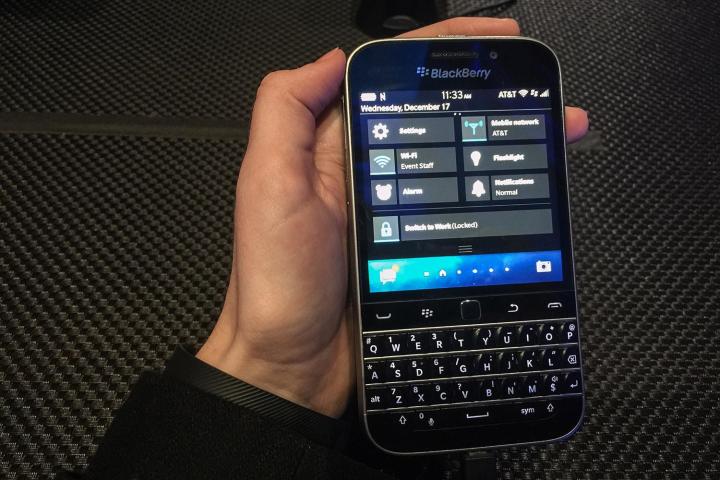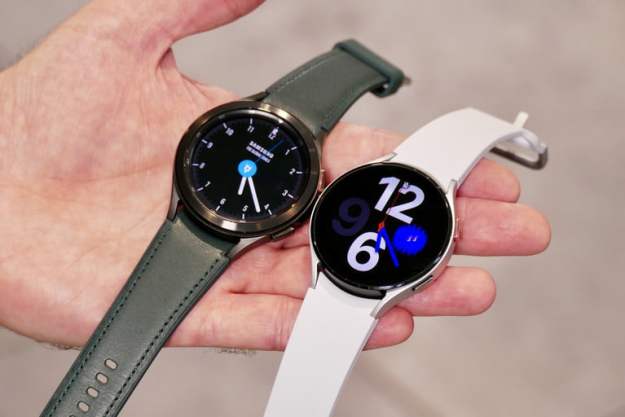The BlackBerry Classic is clearly aimed at traditional BlackBerry fans and enterprise users who place security and speedy communications above all.
BlackBerry finally knows who its customers are. The company may have missed the boat on touchscreens back in the day, but its later attempts to “catch up” to Android and iOS with keyboard-less phones fell flat. Now the company is back to doing what it does best: making phones with full, QWERTY keyboards.
The massively square BlackBerry Passport was just the first of many throwback devices, CEO John Chen claimed earlier this year. Now we have the phone that BlackBerry addicts have been asking for since the Bold 9900 came out in 2011. The BlackBerry Classic couldn’t have a more accurate name if it tried. It’s classic BlackBerry from the top of its curved body to the angled keys of its keyboard.
We had a chance to use the Classic during a launch event in New York City; here are our first impressions.
Hands on video
Classic BlackBerry look
At first glance, you might think the BlackBerry Classic is actually a Bold 9900 in mint condition. It has the same curved body, high-end build quality, and iconic QWERTY keyboard with slightly rounded keys and stainless steel frets between each row of letters. The navigation bar is back, nestled in between the screen and the keyboard. After a moment, though, you realize that the screen is much larger, and the rows of keys aren’t curved at all.
Even though it doesn’t look like it, the Classic’s screen is actually the same size diagonally as that of the iPhone 4S.
The BlackBerry Classic features a few subtle differences in design and a few more substantial ones when it comes to its specifications. The screen is 60 percent larger on the Classic than on the Bold, as the device sports a 3.5-inch square touchscreen with a 720 × 720 pixel resolution and 294ppi pixel density. Even though it doesn’t look like it, the Classic’s screen is actually the same size diagonally as that of the iPhone 4S. It is square, though, so watching videos on YouTube or checking anything out in landscape view leaves an absurd amount of black space above and below the image.
As such, BlackBerry’s Classic isn’t ideal for those who stream Netflix and YouTube videos on their phones during all hours of the day. It is, however, perfectly crafted for the businessman who needs to respond to 100 emails a day and get things done.
Clicky keyboard moves fast
BlackBerry upgraded the keyboard slightly to make it more ergonomic and easy to use. The stainless steel frets add a nice amount of separation to the rows of keys, so users can type without looking. Each key is slightly curved, though the rows aren’t — the keys now sit in straight rows like the ones you see on the BlackBerry Passport. The company says it found the curve wasn’t necessary and the straight line up is actually more comfortable to use.
We typed a few lines of text in Evernote to get a feel for the keyboard, and things moved very fast. The physical keys give a nice clicky feedback that does seem reassuring. Die-hard BlackBerry users who have been clacking away at their QWERTY keyboards for years without interruption will feel right at home. Those who’ve been using touchscreen keyboards all their lives will find it odd at first. Even so, there’s no denying that the keyboard works well.
A BlackBerry representative pointed out that for phone users who are on their keyboards all day, a physical one is ideal. After all, the virtual keyboard takes up the same amount of screen real estate on comparable phones like the Samsung Galaxy S5 and iPhone 6 anyway.
If you’ve been waiting for an upgrade to the Bold 9900, the Classic is the phone for you.
BlackBerry also brought back the navigation bar on the Classic, which has a scrolling trackpad, back button, BlackBerry button, and two more on either side. The trackpad that sits in the center of the navigation bar is touch sensitive, so you can scroll around apps, email, or your browser. It’s very responsive and quick, so you can really jet around the device and scroll through email at warp speed. The trackpad was surprisingly nice to use and it certainly made navigating through apps one-handed much easier than on a phablet.
Upgraded specs bring BlackBerry to 2014
BlackBerry’s Classic may not have incredible specs, but it has enough power to get you through a day or two of intense work. The phone itself is powered by a dual-core, 1.5-GHz Snapdragon S4 processor and 2GB of RAM. BlackBerry offers 16GB internal storage, but a MicroSD card slot sits next to the SIM slot, so you can bring that number up to 128GB. The Classic totes a 2,515mAh battery that BlackBerry says will last 22 hours. Bluetooth 4.0, 4G LTE connectivity, Wi-Fi, an FM radio, and the NFC BlackBerry Tag technology are all included, as well.

The Classic runs BlackBerry’s latest BB 10.3.1 operating system update, which involves a lot of swiping around the screen for navigation. Luckily, you can download apps from the Amazon Android Appstore and the BlackBerry World app store.
To round off the Classic’s spec sheet, BlackBerry included an 8-megapixel back camera with autofocus and a 2-megapixel front-facing camera. We snapped a few pictures with the Classic’s camera at the event, and it focused in on objects well. Overall, it looked like an average camera, and it certainly wasn’t one of the Classic’s strengths.
Conclusion
The BlackBerry Classic is clearly aimed at traditional BlackBerry fans and enterprise users who place security and speedy communications above all. Android and iOS users who’ve never expressed interest in BlackBerry devices before now will not be tempted by the Classic, but that’s not who the company is targeting. If you’ve been waiting for an upgrade to the Bold 9900, the Classic is the phone for you.
Of course, these are just our first impressions, so we’ll have a more fleshed out review once we’ve tested the device at length.
Highs
- QWERTY keyboard for the faithful
- BlackBerry’s security suite
- High-end build quality
- Easy to use one-handed
Lows
- Limited app selection
- Average camera
- May not appeal to non-BlackBerry fans
Editors' Recommendations
- This crazy case adds a BlackBerry-inspired keyboard to your iPhone
- BlackBerry trailer depicts the rise and fall of the iconic phone
- BlackBerry’s latest revival attempt crashes before launch
- The BlackBerry Key2 shows why software updates really matter
- A new BlackBerry with a keyboard is still on the schedule for 2022



